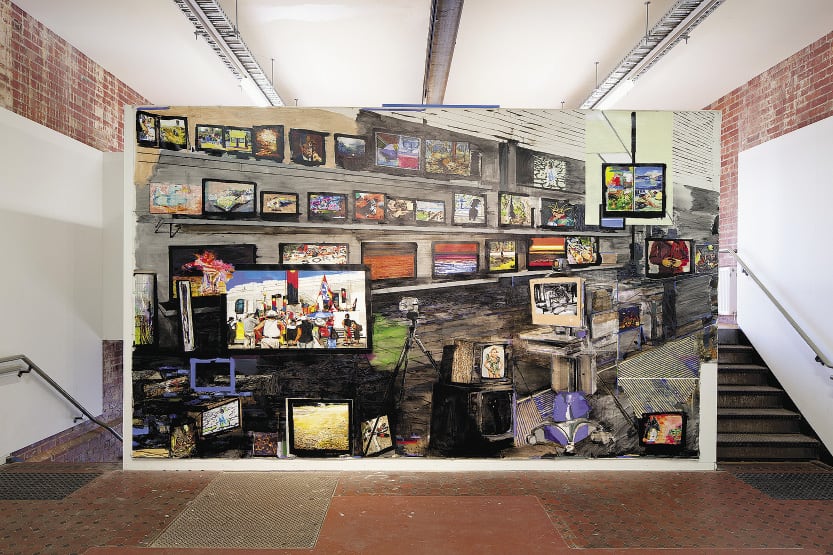
Steven Rendall
Television Project
The Substation, Newport
26 July – 19 August 2012
An enormous painting of a retail television showroom formed the physical and conceptual centre of Television Project, Stephen Rendall’s recent exhibition at The Substation. The painting was initially sketched with blank white spaces on each of the represented television screens. An image of this partial painting was then circulated via email and websites inviting people to submit jpeg images to be painted by Rendall onto the screens.1 The final painting, Study for Shifts and Discontinuities 2012, incorporated over forty such crowd-sourced images, some of which contained further image frames. Emphasising the centrality of this process to the exhibition, adjacent gallery spaces displayed prints of the selection of submitted jpegs, as well as a preliminary sculptural scale model of the exhibition design. Crucial here are circuits of process and production, rather than the self-contained coherence of the painting’s physical frame.
Rendall’s work shares a lineage with artists and painters such as Robert Rauschenberg and David Salle, whose use of repeated images and divided pictorial planes often referenced recognisable televisual events. The canvas was a conduit for an amalgamation of the broadcast images of consumer culture, critiqued and filtered through the hand of the artist.2 Updating such work, Rendall’s painting presents an array of images, some taken from broadcast media, but most reflecting the atomisation of mass media in a networked media environment where production and reception are increasingly collapsed. Here, the screen no longer represents the reception of mass culture but is, instead, a platform for idiosyncratic cultural interests. As such, there are no repetitions of the same image in Study for Shifts and Discontinuities, and the images vary wildly in content and style. Various pictures of pets and personal photographs point to the niche and narcissism of social media, while the prominent inclusion of images of protest suggests optimism for the political capacity of the form.3
The work continues Rendall’s interest in producing a painterly representation of television screens, evident in previous exhibitions such as Fear and Desire Regarding Something Doubtful at John Buckley Gallery in 2011, in which he encloses the frame of the screen within the frame of a painted canvas. Here, though, Rendall’s painting intersects with participatory media and the Internet as a collaborative medium. The work remediates these other media via a strategy of hypermediacy, which overtly combines and juxtaposes painting, television and the Internet in order to draw attention to the surfaces and material frames of each.4 The painting uses its representations of television screens as pictorial motivation for fracturing the surface into manifold planes and images, formally invoking the multiple-window style of the computer screen.5 Close observation reveals little pictorial detail or information: the abstract strokes and expansive site-specific dimensions suggest the painting is to be read from a distance, as panorama or landscape. At the centre of the painting is a camera on a tripod: replacing the easel in a landscape is the camera in a mediascape, where the accumulation and proliferation of images supplant the singular vision of the individual observer. The dispersed planes and gestural brushwork of Rendall’s painting further emphasises processes of reproduction and transmission, with the detail of each image secondary to the flows and energies of the media networks in which they are circulated. The monumentality of the painting’s own physical presence is dissipated by the provisional, almost ramshackle, approach to its hanging and the accumulation of research materials in the adjoining rooms. Painting is not a saviour of the image, but is entangled within the same context.
Just as the technology of electrical distribution has transformed, leaving The Substation to find new uses for its architectural remnants, the technologies of image distribution and reception powered by these networks have evolved and mutated. The impending obsolescence of mass media, and particularly broadcast television, leaves the architecture of the screen in flux, increasingly disjointed and unpredictable. Television Project explores, and revels in, this cultural moment.
Kyle Weise is a PhD candidate at the University of Melbourne, and is co-director of Beam Contemporary and Screen Space galleries.
